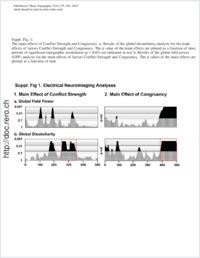High and low stimulus-driven conflict engage segregated brain networks, not quantitatively different resources
- Chouiter, Leila Laboratory for Cognitive and Neurological Sciences, Medicine Department, University of Fribourg, Switzerland
- Dieguez, Sebastian Laboratory for Cognitive and Neurological Sciences, Medicine Department, University of Fribourg, Switzerland
- Annoni, Jean-Marie Laboratory for Cognitive and Neurological Sciences, Medicine Department, University of Fribourg, Switzerland
- Spierer, Lucas Laboratory for Cognitive and Neurological Sciences, Medicine Department, University of Fribourg, Switzerland
-
01.03.2014
Published in:
- Brain Topography. - 2014, vol. 27, no. 2, p. 279–292
English
Task-irrelevant information is constantly present in our environment and may interfere with the processing of the information necessary to achieve goal-directed behavior. While task goals determine which information must be suppressed, the demand for inhibitory control depends on the strength of the interference induced by incoming, task-irrelevant information. Whether the same or distinct inhibitory processes are engaged to suppress various degrees of interference from task-irrelevant information remains largely unresolved. We investigated this question by manipulating the strength of the conflict induced by automatic word reading in a classical color Stroop task. High conflict was induced by presenting words in participant’s native language and low conflict by presenting words in a less familiar language. Behavioral performance and electrical neuroimaging analyses of event-related potentials to the words were analyzed following a two-by-two within-subject design with factors conflict strength (high; low) and color word/word ink congruency (congruent; incongruent). Behaviorally, we observed a significant conflict strength × congruency driven by a smaller Stroop effect in the low- than high conflict condition. Electrophysiologically, we observed a significant conflict strength × congruency interaction at the topographic level during the period of the N450 components, indicative of the engagement of distinct configurations of brain networks. No such interaction was found at the level of response strength. Electrical sources analyses localized the topographic effect within the anterior cingulate cortex and basal ganglia, left middle frontal and occipital areas. We interpret our results in terms of qualitatively distinct executive mechanisms for reactive inhibitory control in conditions of high versus low stimulus-driven conflict.
- Faculty
- Faculté des sciences et de médecine
- Department
- Médecine 3ème année, Département de Médecine
- Language
-
- English
- Classification
- Biological sciences
- License
-
License undefined
- Identifiers
-
- RERO DOC 209517
- DOI 10.1007/s10548-013-0303-0
- Persistent URL
- https://folia.unifr.ch/unifr/documents/303395
Other files
Statistics
Document views: 95
File downloads:
- Document: 231
- Supplementary material: 126

